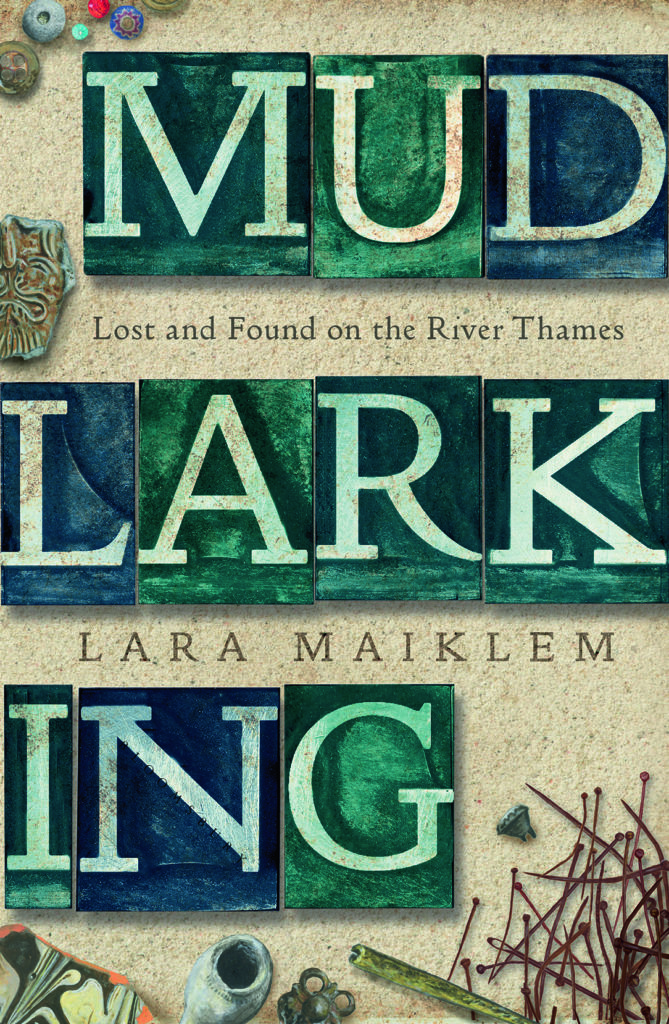Lara Maiklem has scoured the banks of the Thames for over fifteen years, in pursuit of the objects that the river unearths: from Neolithic flints to Roman hair pins, medieval buckles to Tudor buttons, Georgian clay pipes to Victorian toys. In Mudlarking, published by Bloomsbury, she tells the stories of these objects. Melissa Harrison reviews.

It is a chilly, overcast Sunday in September 2016 and my ten-year-old goddaughter and I are walking the Thames foreshore near Tate Modern in companionable silence, stooping a little, eyes down, every so often bending to pick something up. Each of us has a bag full of entirely ordinary treasures: clay pipe stems, seaglass, pottery shards, animal teeth. Obviously we wouldn’t say no to a complete Roman amphora or gold Tudor ring, but we’re both quite happy with our nondescript haul. Just searching is a pleasure; looking and imagining and anticipating. It is hypnotic, even if my neck and back are starting to complain.
Since 2016 – I now learn – permits have been required for all mudlarking on the Thames, even if you’re just picking things up from the surface. All the subsequent trips I’ve made have therefore been in breach of the Port of London Authority’s rules. I presume the crackdown is in response to the growing popularity of this ancient pastime, which, aided by the addictive Instagram feeds of mudlarks like Lara Maiklem (@london.mudlark), has recently become something of a hobby du jour.
Maiklem has been mudlarking for over 15 years and knows the Thames, its tides and beaches, its history and idiosyncrasies, very well indeed. Biographical details are scant in her book, and what there is comes late (that this is notable shows how accustomed we’ve become to the current of memoir in non-fiction) – but we do learn that she grew up in a very old farmhouse, full of the traces of the past. She was a noticing child of noticing parents; once, she found a human jawbone in a graveyard during a picnic, and smuggled it home for her personal museum. I was that kind of child too, and can’t help but secretly approve.
Mudlarking is structured like the river: from the tidal head at Teddington through the city and out to the Hoo Peninsula and the estuary beyond. Maiklem describes each location’s peculiarities from the unique perspective of a mudlark: access to the river, safety and tides, weather, foreshore consistency (and, sometimes, odour), aspect and character, and quality of finds. It allows her to build up a portrait of the city from its earliest beginnings through the Roman settlement, the medieval period, the Great Fire, the Georgian and Victorian city, to today’s ultramodern container ports and shamefully leaking landfills. And through it all wind the stories of the people who have searched the river: ragged women scavenging fragments of coal, urchins stealing ship’s nails, men with their metal detectors.
The historical picture accretes easily and naturally around the margins of the narrative; the main flow of the book is an account of the myriad items, both rare and commonplace, that Maiklem has found on the river, where and how she discovered them, their history (or potential history), and how they relate to the city’s storied past. And what a finds list it is: fossilised shark’s teeth, worked flints, an 18th century cosmetic set, Roman mosaic tiles, a pewter bodkin, Venetian chevron beads, a clay roof tile with the print of a long-dead cat, a Victorian posy ring, human bones, live ordnance, Bellarmine jars, the loaded magazine of a gun, its barrel sawn off and the serial numbers filed away, an 8.2 carat cut garnet, pearl beads, ‘Doves’ type, Elizabethan pins, coins from all eras, thimbles, tokens, porcelain dolls, wedding bands, Hindu diya lamps, human ashes, chafing dishes, medals…I could go on.
One of the things I loved best about Mudlarking was its unpretentiousness. Maiklem’s knowledge and skill are evident and unarguable, but she never writes in the voice of an ‘expert’ handing knowledge down to readers de haut en bas. The book is full of mentions of her looking things up on the internet, scanning museum collections and asking others for help, just as we all do – processes that often disappear from view during the process of writing a book, consciously or unconsciously conferring status on the author at the expense of the inexpert reader, who may admire their discoveries but cannot hope to replicate their skill. By including in her story the process of finding out, Maiklem leaves the door open for the rest of us: with a bit of luck and patience you too, she suggests, could spot something interesting on the foreshore, ask around, take it to a museum and end up owning a little bit of history. What a thrill!
However, Maiklem is equally clear about the difficulties and dangers of her hobby, and by the end of the book there’s no mistaking the fact that she goes to far greater lengths than a couple of hours spent strolling around the shingle at the foot of the Millennium Bridge. There are some genuinely hairy moments here, from incoming tides to sucking mud to slippery ladders, bouts of ‘Thames tummy’, sudden changes in weather and menacing Russians necessitating the involvement of the River Police. It’s a salutary reminder that London’s river can be both untamed and lawless; but for those of us a little less intrepid, there’s her Instagram feed to keep up with, at least.
*
Mudlarking is the current Book of the Week on BBC Radio 4. Listen back to the episodes so far here.
Buy a copy of the book, priced £18.99, here.